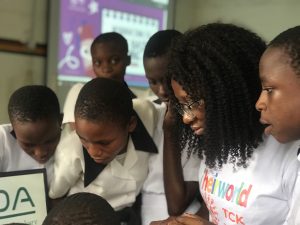In the heart of Africa’s education revolution lies an urgent yet hopeful question: What does the future of STEM education for girls in Africa look like?
Across the continent, a powerful shift is unfolding. More girls are entering science, technology, engineering, and mathematics (STEM) classrooms than ever before. Yet, the future of STEM education for girls in Africa still depends on how we remove persistent barriers and design inclusive opportunities. Despite the global spotlight on gender inclusion, African girls remain significantly underrepresented in STEM-related academic tracks and careers a challenge rooted in cultural, systemic, and structural barriers.

Why STEM for Girls Matters More Than Ever
STEM skills are becoming the foundation for jobs, innovation, and problem-solving across Africa. With over 70% of Africa’s population under 30, the continent’s future depends on its youth. If girls are excluded from STEM, we lose out on half of the continent’s potential.
Empowering girls with STEM education does more than close gender gaps. It opens doors to dignified work, sparks innovation in local communities, and creates ripple effects that uplift entire families and economies. According to a report by UN Women, increasing women’s participation in STEM can significantly boost a country’s GDP and social outcomes.
The digital gender divide remains a significant barrier to achieving gender equality. Women and girls, especially in developing countries, have less access to digital technologies, limiting their opportunities in education, employment, and civic participation.
Challenges That Still Exist
Despite growing awareness, girls in Africa still face many roadblocks when it comes to STEM. In many schools, science labs are under-resourced. Qualified STEM teachers are rare. Cultural norms often label science and technology as “male” fields.
These factors combine to discourage girls early. By the time many reach secondary school, they are less confident in science and math. This limits their chances of pursuing higher education or STEM careers later in life.
In rural communities, this problem is magnified by infrastructure gaps, digital illiteracy, and lack of exposure to female role models in STEM fields.
Building a Better Future: What Needs to Change
The future of STEM education for girls in Africa is not a far-off ideal. It is already unfolding through grassroots innovation, bold policy shifts, and the relentless drive of educators, nonprofits, and young trailblazers across the continent.
We’re seeing the rise of community-based STEM clubs, mobile science labs, and digital platforms that teach coding, robotics, and engineering in languages and contexts that African girls understand. Governments in countries like Rwanda, Nigeria, and Kenya are beginning to integrate gender-responsive STEM policies into national education strategies.
But for this future to be sustainable, it must be:
- Locally relevant: STEM education should respond to local challenges and opportunities, from agriculture to climate change.
- Inclusive and adaptive: Digital platforms must be designed for low-bandwidth environments, with accessibility for girls in rural and low-income areas.
- Mentorship-driven: Connecting girls to African women in STEM through mentorship, storytelling, and peer communities builds confidence and aspiration.

The Role of EdTech and Digital Innovation
Digital education is a game-changer especially for girls who face mobility restrictions or school dropouts due to early marriage, pregnancy, or caregiving roles. EdTech solutions offer flexible, scalable alternatives, providing on-demand access to science content, coding programs, and interactive learning tools.
The future of STEM education for girls in Africa must go beyond simply teaching science and math. It must reshape how girls see themselves as problem-solvers, inventors, leaders. Representation matters. So does narrative. Girls should drive STEM.
This requires more than just infrastructure or content. It calls for a mindset shift in schools, in families, and in policy. And that shift must begin now.
Africa’s future will be built by its youth and girls must be at the center of that story. A continent as dynamic, diverse, and creative as Africa cannot afford to exclude half its talent from the tech and innovation economy.
By investing in sustainable, inclusive, and forward-thinking STEM education for girls, we are shaping industries, communities, and entire nations for generations to come.
In every workshop I lead, every school I support, and every project I design, I prioritize inclusion and identity.
Want to co-create a STEM program that empowers girls? Explore my STEM Education Program Service or reach out to start a conversation.



No comment yet, add your voice below!